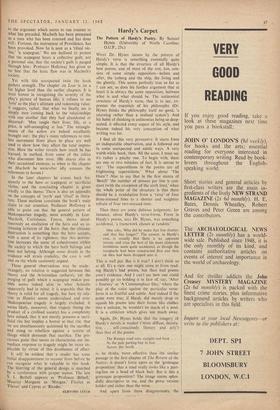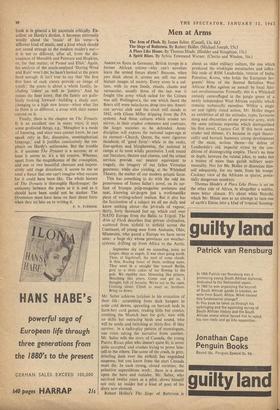Hardy's Carpet
WHAT Dr. Hynes means by the pattern of Hardy's verse is something essentially quite simple. It is that the structure of all Hardy's best poems, and of most of the rest, too, con- sists of some simple opposition—before and after, the iceberg and the ship, the living and the ghostly. This seems perfectly true as far as ! can see, as does his further argument that at heart it is always the same opposition, between what is and what should be. The antinomial structure of Hardy's verse, that is to say, ex- presses the essentials of his philosophy (Dr. Hynes thinks the philosophy itself no good, 'a yearning rather than a realised system'). And his habit of thinking in antinomies being so deep-- seated, it affected every aspect of his style, and became indeed his very conception .of what writing was for.
I find all this very persuasive. It starts from an indisputable observation, and is followed out in some unexpected and subtle ways. A very worth-while book, then. All the same, I must say it's rather a patchy one. To begin with, there are one or two mistakes of fact. It is untrue to say: 'The superstitions in the poems are all frightening superstitions.' What about 'The Oxen'? Also to say that in the first stanza of 'Bereft' 'the number of stresses per line is con- stant (with the exception of the sixth line),' when the whole point of the structure is that there should be a modulation from a 'verse' of four three-stressed lines to a shorter and weightier refrain of four two-stressed ones.
Then there are some dubious judgments; for instance, about Hardy's verse-forms. Form in Hardy's poems, says Dr. Hynes, was something accidental, 'a framework chosen at random.'
One asks. 'Why did he make that line shorter, and that line longer'?' The answer, in Hardy's case, is usually that there is no apparent reason, and even the best of his more elaborate inventions seem quite accidental, as though the receptacle had been constructed first and then an idea had been dropped into it.
This is well put. But is it true? I don't think so at all. It's a view one might come to from read- ing Hardy's bad poems, but then bad poems aren't evidence. And 1 can't see how one could possibly go on holding it in face of, say, 'After a Journey' or 'A Commonplace Day,' where the play of the voice against the particular verse- form is so fruitful and subtle. And indeed if the point were true, if Hardy did merely drop or squash his poems into their forms like clothes into a suitcase, he wouldn't be much of a poet. It is a criticism which gives too much away.
Again, Dr. Hynes holds that the imagery of Hardy's novels is weaker ('more diffuse, decora- tive, . . . self-consciously literary and arty') than that of the poems.
The Roman road runs straight and bare As the pale parting-line in hair Across the heath . . .
is, he thinks, more effective than the similar passage in the first chapter of The Return of the Native; it doesn't force upon us the 'grotesque proposition' that a road really looks like a part- ing-line on a head of black hair. But is this a grotesque proposition? The image seems splen- didly descriptive to me, and the prose version bolder and richer than the verse.
And apart from these disagreements, the
book is in general a bit uncertain critically. Ex- cellent on Hardy's diction, it becomes extremely woolly about the 'music' of his verse—`a different kind of music, and a kind which should not sound strange to the modern reader's ear— it is not so different, after all, from the dis- sonances of Meredith and Patmore and Hopkins, or, for that matter, of Pound and Eliot.' Again, his analysis of the much-analysed 'During Wind and Rain' won't do; he hasn't looked at the poem hard enough. It isn't true to say that 'the first five lines of each stanza provide an image of youth'; the poem is about a whole family, in- cluding 'elders' as well as 'juniors.' And he misses the finer irony, that the family are guile- lessly looking forward—building a shady seat, changing to a high new house—when what lies in front is so different, a stone with their names carved on it.
Finally, there is the chapter on The Dynasts. It is an excellent one in many ways; it says some profound things, e.g., 'Metaphor is a mode of knowing, and since man cannot know, he can speak only in flat, discursive, unmetaphorical language,' and it justifies conclusively the em- phasis on Hardy's antinomies. But the trouble is, it assumes The Dynasts is a success; or at least it seems to, it's a bit evasive. 'Whereas, apart from the magnificence of the conception, and one or two beautiful choruses and impres- sively odd stage directions, it seems to me so total a fiasco that one can't imagine what success for it could have been like. The whole history of The Dynasts is thoroughly Hardyesque; the antinomy between the poem as it is and as it should have been could not be starker. The Doomsters must have been on their direst form when they set him on to writing it.
P. N. FURBANK































 Previous page
Previous page